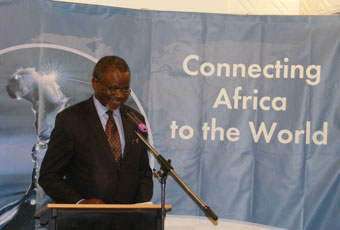
By Joe Powell
July 23, 2009, 159 years after the world’s first submarine cable was laid, will go down in history as the day East Africa became fully connected to the world’s digital super-highways. Seacom’s cable, 17,000km long and costing $650 million, is now officially ‘live’ with a capacity of 1,28 Terabytes per second, the equivalent of hosting two million international phone calls simultaneously.
Unsurprisingly hyperbole was not on short supply at the launch event. Cisco’s representative announced, “We will change the way Africans work, live, learn and play with the rest of the world”. Seacom CEO Brian Herlihy urged the African youth to wake up every morning asking them “are we dreaming big enough?” An excitable Tanzanian President Jakaya Kikwete, speaking from Dar es Salaam live via video link, declared his country ready for “e-commerce, e-government, e-everything”.
However, a series of revelations have come to the attention of The Independent that threaten to take the gloss of this indisputably momentous time for telecommunications in Uganda.
The first concerns the role of Ugandan Internet provider Infocom, who alongside their sister company Kenya Data Network (KDN) have managed to secure the only fibre optic cable running from Mombasa to Kampala. Altech Stream Holdings Ltd, a South African company, took a majority stake in Infocom and KDN in March last year. However, while KDN laid their own cable from Mombasa to Malaba, Infocom is leasing the Malaba to Kampala section from the Uganda Electricity Transmission Company (UETCL), a government power utility. UETCL laid the cable primarily for power purposes, but have begun leasing out excess capacity to telecoms companies.
However, confusion has arisen over whether UETCL’s cable is being considered part of the National Data Transmission Backbone Infrastructure (NBI), a government project. The NBI blueprints include laying a cable from Kampala to Busia, an apparent duplication of government expenditure given the UETCL cable. The CEO of UETCL Eriasi Kyemba told The Independent that while they couldn’t agree to an ICT Ministry takeover of the cable, they would consider a leasing arrangement if approached.
Infocom’s grip over Uganda’s use of the Seacom cable is further strengthened as they have been appointed the hub provider for the country, what is known as a “˜backhold provider’. This means that companies seeking to buy bandwidth capacity will have to negotiate with Infocom, currently the only company to have a contract with Seacom. A telecoms insider talking to The Independent said this brings in clear competition concerns as Infocom are also planning to provide Internet services to consumers. While ICT Minister of State Alintuma Nsambu rejected this arrangement as clearly “not allowed”, Infocom CEO Hans Haerdtle defended his company’s position as “no different to what other countries have”. Haerdtle said he saw no problem with “Infocom competing with other operators while being a backhold provider” and cited infrastructure-sharing agreements with rival companies as evidence they could be reasonable. The Independent has learnt, however, that Infocom will be retaining exclusive rights over the countrywide network of 16 WiMAX sites, which will be able to utilise the faster Internet via microwave even while the NBI remains incomplete.
Infocom have been fortunate that rivals such as MTN and UTL invested in an alternative submarine cable, Eassy, which is running behind schedule and will not go live for at least a year. Both MTN and UTL have a superior fibre and copper network countrywide but without a deal with Seacom are in danger of being left behind.
The third submarine cable, Teams, has docked at Mombasa and is now undergoing final testing. Teams have significant investment from the Kenyan Government. Sources have confirmed that telecoms companies in Uganda are now scrambling to buy bandwidth from Seacom and Teams directly, with one senior executive telling The Independent anonymously that there is no way they would tolerate working through Infocom.
Issues surrounding the NBI are another clear concern for those wanting to take advantage of Seacom’s cable. Seacom’s representative in Uganda, Fred Moturi, told The Independent that the government would be largely responsible for laying cable to remote parts of the country, as it is unlikely the private sector would find it profitable. Currently the government has only completed cable from Kampala to Entebbe, Bombo and Jinja. “It’s almost like people never believed this would ever come to the East coast because there have been so many attempts and false starts” Moturi said. The 2,130km $106 million NBI plans in place would, though, cover a large chunk of the country, with Minister for ICT Aggrey Awori claiming the second of the four phases would be finished by the end of the year. The cost of the project has raised questions given that Rwanda was able to lay 2,300 km of fibre cable at a cost of $38 million. The company that won the Uganda contract, Huawei Technologies, donated $2 million worth of communication equipment during the tendering process. Analysts at the time speculated that this may have been contrary to the principles of a fair tender.Â
Information obtained by The Independent also shows that Moturi’s fears are well founded. Cabinet documents show that the government has no money for phase IV of the project, leaving over a third of the country out of the fibre revolution. The phase IV cable is designed to stretch from Mbale through Kapchowa, Moroto, Kotido, Kitgum, Gulu, Adjumani, Arua, Nebbi, Pakwach and rejoins the network in the Amuru region. Some representatives of West Nile region said this is further evidence of government marginalisation of northern Uganda.
Areas that will be connected to the NBI are likely to witness improved economic development. Alongside business development, improved connectivity has huge potential in the education and healthcare sectors. In preparation for the cable’s arrival upcountry Nsambu said that all government secondary schools will have IT laboratories by the end of the year. For Uganda as a whole the arrival of Seacom’s capacity, which will be joined by rival submarine cables Teams and EASSy within the next year, means the country will be able to compete with South Asia in areas such as call centres, business outsourcing and software development. A recent World Bank study found that for every ten percentage points increase in connectivity a country can expect a 4.6% increase in exports and a 1.3% bump in GDP. The business community, who currently pay in the region of $5000 per megabit per month to access the Internet by satellite, will also welcome the reduced costs.
In comparison Seacom wholesale at between $50-150 for the same access, although with Infocom taking their cut the retail price is likely to be higher.
The Independent has learnt, though, that there is another risk to Uganda’s digital future. Currently there are no plans in place to build a second link to the Mombasa landing sites of the three planned submarine cables. Uganda’s over-reliance on links through Kenya has been exposed twice in recent years, with the fuel shortages of January 2008 after the Kenyan election violence and the tearing up of the rail link by thugs in Kibera over the Migingo island bilateral dispute. Nsambu revealed that the satellite infrastructure would be kept in place as a back up in case of any interruption. President Kikwete also announced plans for terrestrial cable to run from Dar es Salaam to Burundi, Rwanda and Uganda, although no timescale was placed on the project.
The ICT Ministry is planning a new Bill to address some of these issues, with Awori promising it will be tabled within 45 days. According to Nsambu the Bill seeks to provide the necessary regulation to ensure that the Uganda Communications Commission (UCC) can effectively manage the new services.
The ministry itself has been the subject of speculation over whether it has the funding and personnel to effectively run the country’s ICT sector. At the last budget it received only Shs6.5 billion, by far the lowest allocation of any ministry and amounting to 0.1% of the government’s total spending. This is partially offset as the UCC is supposed to take 1% of the profit of each telecoms company, the majority of which is directed at ICT in government schools. The appointment of Awori as the cabinet minister for ICT also raised eyebrows in the industry, with the popular and knowledgeable Ham Mulira shifted to presidential advisory duties.
Despite the complications uncovered by The Independent this should remain a time for optimism in Uganda’s ICT sector. The arrival of high-speed Internet will revolutionise the way of doing business for those able to use it. However, until questions of ownership, security, upcountry access and the role of Infocom are cleared up, there will continue to be scepticism over the extent of the benefits Ugandans will receive.
 The Independent Uganda: You get the Truth we Pay the Price
The Independent Uganda: You get the Truth we Pay the Price



